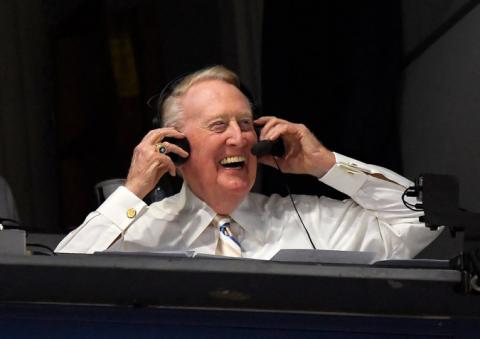Broadcast Booth Blues
New York Times
October 7, 2016
by Doug Glanville
Could it be that calling the play-by-play for a ballgame is tougher than playing major-league center field?
With the end of Major League Baseball’s 2016 regular season came a special kind of silence: Dodgers fans who had been listening to the golden voice of Vin Scully since 1950 will no longer hear his poetic descriptions harmonizing with baseball’s artistry. One of the great broadcasters in sports has retired (he won’t be doing the Dodgers’ post-season, which begins this weekend).
Scully is irreplaceable. Certainly by me. For the first time, recently, I was given the chance to call, on television, the play-by-play of a major league game, a rainy evening that stacked the thunderous lineup of the Detroit Tigers against the athletic and speedy Cleveland Indians. I’m an analyst, not an announcer, but I was doing some pinch hitting of my own because Jon Sciambi, our play-by-play voice, had been taken down by strep. I discovered that to truly describe art, it helps to be an artist in your own right. Otherwise, your voice may be working against the natural poetry that exists in the game, which at times requires no words.
Let me explain what I mean by using the example of Miguel Cabrera of the Tigers. Cabrera is one of the greatest hitters ever. In conversation, I can easily describe why. He has exceptional balance, he keeps his head frozen for a laser-efficient line of sight, his base that anchors him into the ground is rock strong, and he has an almost innate ability to trust his hands for so long that he hits the baseball practically out of the catcher’s mitt. He uses that bonus time to direct his hits as if he were the best tennis player on earth, deceiving the pitcher and the defense until the ball’s last breath through the strike zone.
Coupled with Cabrera’s hitting prowess is what he looks like in real time: When he smacks the ball, it defies expectations because the ease with which he swings does not align with the sizzling speed and distance it travels after he makes contact. It carries, it rides an invisible jet stream, top flight created by top-gun hitter, creating anomalous trajectories that benefit him.
I have an extensive body of playing experience that can minimize the surprise of greatness, but I also remember what it was like to play against (and with) someone who did something that stood out even by major league standards. Players would then look at one another as if to say, “Did you see that?” There is nothing more stunning than wowing the best in the world.
Twice in my five innings of calling my first game (it was stopped because of rain), I found myself reduced to silence, wordless to describe why a shot off the bat of Cabrera that looked like it was going to hit the second baseman instead hit the wall in right-centerfield. Then, a couple of innings later, to make a mockery of my debut, Cabrera hit another one that rocketed over the head of the right fielder, who turned around and got to watch the ball sail into the stands. For me, it was hard to make an exciting home run call when you thought the ball was going to hit the right fielder in the back. If I’d been playing my old position, center field, I might have known at the point of contact that it was going out, but from the booth things weren’t so clear to me.
Cabrera represents what I found to be the toughest challenge of calling play-by-play: You must find a way, noncommittal yet with confidence and certainty, to involve and even excite an audience about what is starting to happen before the play actually resolves.
Earlier in September, Vin Scully was working a game that I was also calling as a color analyst, and he described a ball being hit “over the head” of the Dodger right fielder Yasiel Puig, which in my mind suggested that it was not going to be caught. But then Scully magically described Puig corralling the ball in his glove. So how was the ball both “over his head” and caught? Well, it was over his head in real time, and in discovering that Puig caught it, Scully made both the play and the call of the play sensational. Lesson learned. Describe it, and if the play takes you another direction, embrace it. The play’s momentum probably changed direction because of something special.
As an announcer calling the details of the game, you must find the crescendo to inspire, paired with the speech efficiency to be precise. I imagine that the more a player can surprise you and create doubt in your precision, the greater the player must be. He is unpredictable, living outside the realm of rote characterizations, doing what we least expect, and at the last moment. He deserves, at the very least, superlatives; at the very best, pure silence, even though your job requires you to speak.
For players interested in broadcasting, that usually means becoming a color analyst, and that’s what I did. This requires me to wait until the play is over, then I tell the listener or viewer why it happened and how. That is my timeline, I have the luxury of completion, framing what already took place with context, rarely in doubt about what transpired. Yet calling each play in sync with what a viewer is seeing — or even not seeing — places you at the edge of real time. It is a split second or two that makes the difference between brilliant call-making and tardy statements of the obvious.
Game-changing moments of excellence challenge the craft of describing them. They take your breath away, not fuel it to engage speech. The equilibrium you seek in calling a game is finding a way to speak while respecting that at times (see Miguel Cabrera, above) you must internalize silent awe. You don’t interrupt something that words may not do justice to, unless those words measure up to the beauty of what is unfolding.
I imagine that is what we loved about Vin Scully, beyond his keen ability to do both color and play-by-play simultaneously. He was an announcer who spoke eloquently to our passions while baseball history was being made. Over 67 seasons, Scully’s signature work made it clear that he was a rare artist, and that the picture he was painting was not just valuable, but instantly timeless.
Republished from The New York Times
Photo: Vin Scully in the broadcast booth last month.
Photo Credit: Mark J. Terrill/Associated Press






